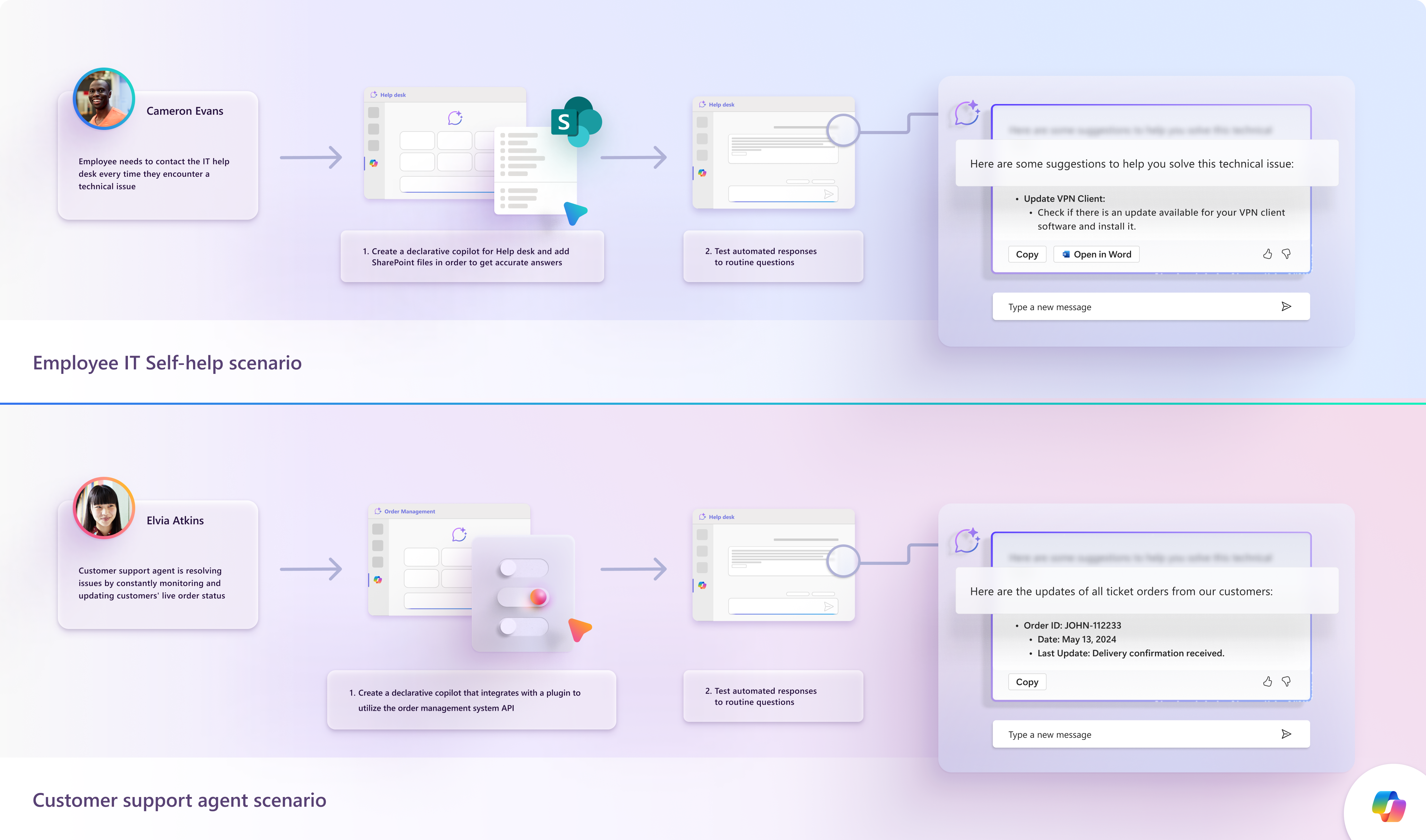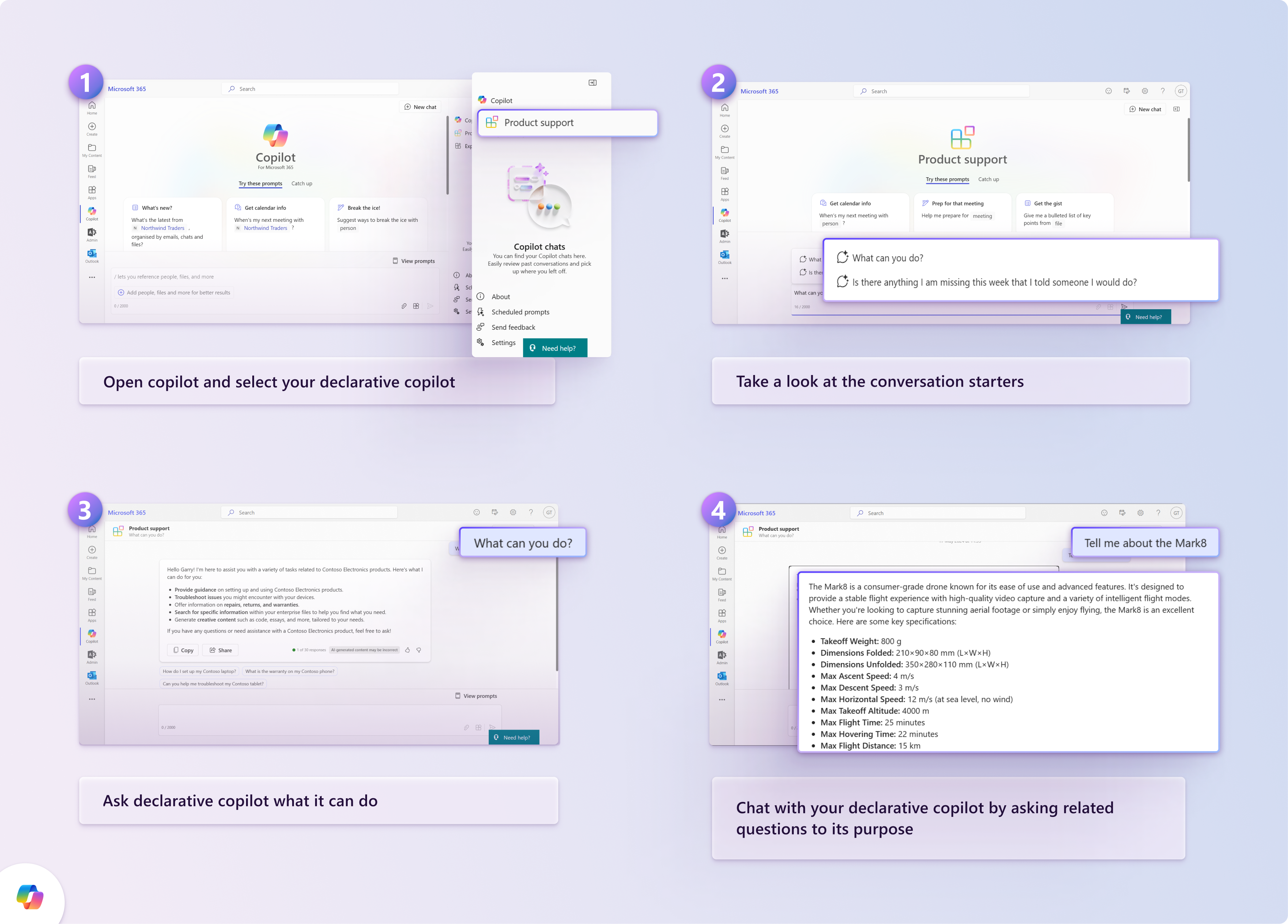Declarative copilots for Microsoft 365 overview
Building a declarative copilot allows you to craft your own copilot by declaring instructions, actions, and knowledge to customize Copilot for Microsoft 365. Declarative copilots run on the same orchestrator, foundation models, and trusted AI services that power Microsoft Copilot. By tailoring Microsoft Copilot for your business purposes, declarative copilots facilitate smoother collaboration, increased productivity, and streamlined workflows. With declarative copilots, you can establish consistent, personalized experiences and automate intricate processes, ranging from team onboarding to resolving customer issues efficiently.
Important
Declarative copilots for Microsoft 365 are in private preview.
Tailor declarative copilots for your scenario
Declarative copilots are powered by Copilot for Microsoft 365, therefore they utilize the same scalable infrastructure and platform while their purposes are designed for your business needs. Learn more about the use cases for declarative copilots by taking a look at these two example scenarios:
Employee IT self-help with enhanced knowledge: Imagine a world where your employees can serve their needs and depend less on the internal IT help desk for every technical issue they encounter. You can now streamline and simplify IT workflows by building a declarative copilot to expedite resolution of common issues. This specialized copilot draws from internal curated knowledge on SharePoint sites to provide employees faster and effective assistance to employees while saving you costs.
Real-time customer support with seamless system integrations: Assume having a team of support agents dedicated to providing your customers adequate and timely support while constantly monitoring and updating customers' live order status. You can increase their productivity by enhancing your existing process with a declarative copilot. A copilot that seamlessly integrates with a plugin for the order management system to access and provide real-time order updates to customers.
Explore the benefits of declarative copilots
You can engage with declarative copilots within the same interface of Copilot for Microsoft 365. Inside the Copilot for Microsoft 365 interface, you can access declarative copilots by opening the right-hand side menu.
Core benefits of implementing declarative copilots into your operations include:
- Familiar user interface: Declarative copilots utilize the same friendly user interface with Copilot for Microsoft 365. You can adopt and engage with these copilots tailored for their business scenario that look and feel like Copilot for Microsoft 365.
- Enhanced enterprise knowledge: Similar to Copilot for Microsoft 365, declarative copilots can also utilize enterprise data from Graph Connectors and SharePoint files. By applying existing enterprise knowledge and the familiar Copilot interface, you can streamline their workflows, making it easier to engage with data within the organization.
- Seamless integration with plugins: Enterprises can extend declarative copilots using plugins to retrieve data and execute tasks on external systems. Declarative copilots can utilize multiple plugins at the same time.
- Prioritized security, privacy, and compliance: For prioritizing Security, Privacy and Compliance for the enterprise, declarative copilots are built on a secure foundation, inheriting all data protections provided by Copilot for Microsoft 365. Enterprise admins have visibility and control over the distribution of declarative copilots within their tenant via the Microsoft Admin Center console.
Build declarative copilots
Take a look at the core elements required for building a declarative copilot app package:
- App manifest: Describes how your app is configured, including its capabilities, required resources, and other important attributes.
- App icons: Each package requires a color and outline icon for your declarative copilot.
- Declarative copilot manifest: Describes how your declarative copilot is configured, including its required fields, capabilities, conversation starters, and actions.
- Plugin manifest (Optional): Describes how your plugin is configured, including its required fields and capabilities.
Declarative copilot's app package and its core elements mentioned can be created with any tool of choice. For a smooth getting started experience, you can start building declarative copilots by selecting one of the appropriate toolsets that suits your specific scenario. The following table shows the options of recommended toolsets to get started.
| Start with | Summary |
|---|---|
| Teams Toolkit (Private Preview) | Build declarative copilots using Teams Toolkit and Teams Toolkit CLI. |
| Copilot Studio (Private Preview) | Build declarative copilots using the builder integrated in Copilot Studio. |
| Microsoft 365 Admin Center (Private Preview) | Build declarative copilots using grounding data from Microsoft Graph connectors. |
| SharePoint (Private Preview) | Build declarative copilots using grounding data from SharePoint files. |
See also
Palaute
Tulossa pian: Vuoden 2024 aikana poistamme asteittain GitHub Issuesin käytöstä sisällön palautemekanismina ja korvaamme sen uudella palautejärjestelmällä. Lisätietoja on täällä: https://aka.ms/ContentUserFeedback.
Lähetä ja näytä palaute kohteelle

